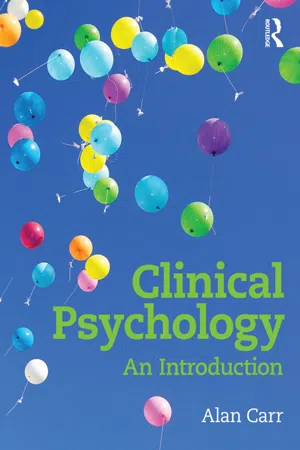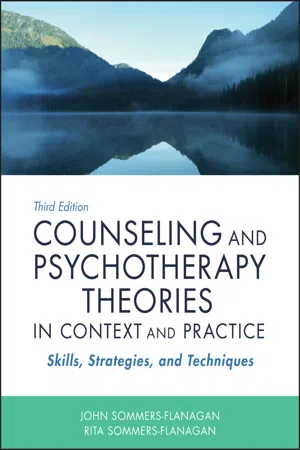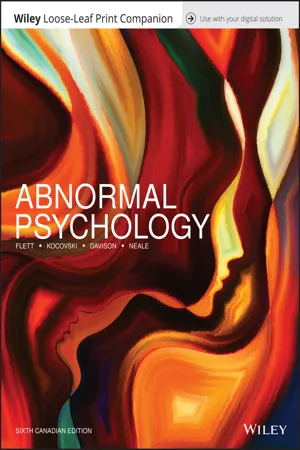Psychology
Effectiveness of Therapy
The effectiveness of therapy refers to the degree to which a therapeutic intervention produces the desired outcomes for a client. It is typically measured by assessing changes in symptoms, functioning, and overall well-being. Evaluating the effectiveness of therapy involves considering factors such as the type of therapy used, the client's specific needs, and the quality of the therapeutic relationship.
Written by Perlego with AI-assistance
Related key terms
1 of 5
7 Key excerpts on "Effectiveness of Therapy"
- eBook - ePub
Clinical Psychology
An Introduction
- Alan Carr(Author)
- 2012(Publication Date)
- Routledge(Publisher)
10 Effectiveness of psychological therapiesLearning objectives After studying this chapter you will be able to:- • define evidence-based practice in clinical psychology
- • explain the hierarchy of evidence that informs evidence-based practice
- • summarize the main findings from the evidence base for the effectiveness of psychotherapy
- • outline the medical cost offset associated with psychotherapy
- • describe the role of common and specific factors in the effectiveness of psychotherapy.
Introduction
One of the main ways in which clinical psychologists help clients is through psychotherapy. Psychotherapy is a contractual process in which trained professionals with expert knowledge of their discipline interact with clients to help them resolve psychological problems and address mental health difficulties. Psychotherapy may be offered to children and adults on an individual, couple, family or group basis.Often clinical psychologists offer psychotherapy as one element of a multimodal programme provided by a multidisciplinary team. For example, a multidisciplinary adult mental health team may routinely offer a multimodal programme of cognitive behaviour therapy combined with antidepressants for depression, as described in Chapter 6 . A multidisciplinary child and adolescent mental health team may routinely offer a multimodal programme for children with attention deficit hyper-activity disorder which includes behavioural parent training, school-based behavioural consultation, child-focused self-instructional and social training and methylphenidate, as outlined in Chapter 2 - eBook - PDF
Counseling and Psychotherapy Theories in Context and Practice
Skills, Strategies, and Techniques
- John Sommers-Flanagan, Rita Sommers-Flanagan(Authors)
- 2018(Publication Date)
- Wiley(Publisher)
Further, they don’t view the understanding or implementation of common factors in psychotherapy as an “important per-sonal activity and goal” (p. 483). Baker, McFall, and Shoham (2008) argued that treat-ments based on efficacy research (i.e., RCTs) generally remain highly efficacious when directly “exported” to clinical settings. Their position is aligned with the medi-cal model and strongly values efficacy research as the road to developing valid psychological procedures for treating medical conditions. However, other research-ers are less optimistic about the ease, utility, and validity of generalizing efficacy research into real-world clinical settings (Santucci, Thomassin, Petrovic, & Weisz, 2015; Singer & Greeno, 2013). Effectiveness Research Sternberg, Roediger, and Halpern (2007) described effectiveness studies: An effectiveness study is one that considers the outcome of psychological treatment, as it is delivered in real-world settings. Effectiveness studies can be methodologically rigorous …, but they do not include random assignment to treatment conditions or placebo control groups. (p. 208) Effectiveness research focuses on collecting data with external validity. This usually involves a “real-world” set-ting, instead of a laboratory. Effectiveness research can be scientifically rigorous, but it doesn’t involve random assignment to treatment and control conditions. Similarly, inclusion and exclusion criteria for clients to participate are less rigid and more like actual clinical practice, where clients come to therapy with a mix of different symptoms or diagnoses. The purpose is to evaluate counseling and psychotherapy as it is practiced in the real world. Other Research Models Other research models are also used to inform research-ers and clinical practitioners about therapy process and outcomes. These models include survey research, single-case designs, and qualitative studies. - eBook - PDF
- Gordon L. Flett, Nancy L. Kocovski, Gerald C. Davison, John M. Neale(Authors)
- 2018(Publication Date)
- Wiley(Publisher)
According to Foa et al. (2013), these factors range from therapists being influenced by former mentors who did not use exposure techniques to not feeling competent enough to implement new techniques while also being hesitant to expose already trauma- tized people to stimuli (e.g., reminders of war) that can add to their distress. So, what has been done to bridge the gap between research and practice? The availability of vast resources (including the controlled outcome study, typically conducted in an academic research setting. The effectiveness of an intervention is its impact when offered to and received by people in the every- day world. According to Dobson and Hamilton (2002), efficacy researchers emphasize maximizing the internal validity of research, often conducted in controlled laboratory settings, while effectiveness researchers hope to optimize the external validity or generalizability of the intervention. The elimination of observable, well-defined problems, such as a person with agoraphobia being unable to venture far from his or her home, is the usual focus of efficacy studies. In contrast, effectiveness is usually judged subjectively by clients themselves based on more global criteria, such as their level of satisfaction with their therapy, how much they believe they have been helped, and how much the quality of their life has improved (cf. Consumer Reports, 1995; Seligman, 1995). The efficacy of treatments is often well-established but evidence of effectiveness lags well behind. This is not always the case, however. Stewart and Chambless (2009) reported a meta-analysis of effectiveness studies of CBT for adult anxiety real-world barriers to implementation. For instance, a recent survey of 19 clinicians examined issues that limited the imple- mentation of dialectical behaviour therapy (see Chapter 13) in the public health system in northern California. - eBook - PDF
- Mona Sue Weissmark, Daniel A. Giacomo(Authors)
- 2008(Publication Date)
- University of Chicago Press(Publisher)
There is now little doubt that therapy treatments are, in general, beneficial. In fact, the impact of therapy often equals or surpasses the effects of other educational or medical efforts. Researchers have developed methods to assess the effects of psychotherapy change, broadly defined. They find the improvement in the health of therapy clients greater, for example, than the gains in reading of elementary-school students given nine months of reading instruction or than the effects of aspirin on heart attacks (Rosnow and Rosenthal, 1989). (See Rosenthal, 1983, for a clear presentation of com- putational formulas and for the “binomial effect size display” as a guide for communicating the practical consequences of treatment interventions.) The benefits of therapy also compare favorably with those yielded by anti- 18 O N E depressant drugs. Still, some problems-addictions, for example-often recur, even with therapy. And some clients remain unmoved by therapy or even get worse. But, on the average, investigators have shown that clients who receive a broad range of therapies improve more than they would with no treatment, with placebo treatment, or through spontaneous recovery. Beyond this global testimony to the Effectiveness of Therapy, investiga- tors have been less successful in their efforts to discover whether some ther- apies work better than others. Smith and Glass (1977) concluded from their meta-analytic study that the evidence overwhelmingly supported the efficacy of therapy but that different types of therapy did not produce dif- ferent benefits: We did not expect that the demonstrable benefits of quite different types of psychotherapy would be so little different. It is the most star- tling and intriguing finding we came across. All psychotherapy re- searchers should be prompted to ask how it can be so. - eBook - PDF
What Works for Whom?, Second Edition
A Critical Review of Psychotherapy Research
- Anthony Roth, Peter Fonagy(Authors)
- 2013(Publication Date)
- The Guilford Press(Publisher)
The tension between naturalistic assessment of outcome and experimen- tal measures of efficacy is a real one, and it should be recognized that the bridge between research trials and routine treatment is difficult to span. It is reasonably clear that, in general, “research therapy” appears to be more effec- tive than everyday clinical practice (Shadish et al., 2000; Weisz et al., 1995a). There are many reasons why this could be. Some of the more obvious rea- sons relate to methodological issues—among them the use of focused and structured treatments, regular access to supervision, participants recruited by advertisement rather than through clinical services, and greater exclusion rates. However, the vicissitudes of biology and individual psychological dif- ferences in treatment response may also be relevant. Psychotherapy is a highly complex interchange in which a large number of factors interact, any one of which could significantly influence outcome. Patients differ along many dimensions, including their socioeconomic circumstances, the stage of their disorder at the time of presentation, and in their premorbid psychological functioning. Similarly, therapists vary in their personality, their skills, their motivation, their ability to comprehend their patients’ problems, and their adherence to treatment modalities. Service provision also varies in important ways, including the length of treatment offered, the quality of liaison with other services, the support and supervision offered to practitioners, and the physical resources available. Research and Practice 17 All these factors are known to interact in a highly complex manner and are subjected to systematic scrutiny in research on psychotherapy process. In principle, much of this work is beyond the scope of this review. Orlinsky et al. (1994) provide a comprehensive overview of progress in this field. How- ever, they note that the distinction between process and outcome research can become blurred. - eBook - PDF
Introduction to Clinical Psychology
Bridging Science and Practice
- Douglas A. Bernstein, Bethany A. Teachman, Bunmi O. Olatunji, Scott O. Lilienfeld(Authors)
- 2020(Publication Date)
- Cambridge University Press(Publisher)
What conclusions are most reasonable given the kind of evidence available? Research on this question is bearing fruit, and as we describe in the next section, shows that some psychotherapies are indeed more effect- ive than others, not necessarily overall, but for particular problems. One meta-analysis found, for example, that cognitive behavior therapy was more beneficial in cases of social anxiety disorder than psychodynamic psychotherapy, interpersonal psychotherapy, mindfulness, and supportive therapy (Mayo-Wilson et al., 2014). Another meta-analysis found an effect size that favored cognitive behavior therapy over other psychotherapies in the treatment of anxiety disorders in general (Tolin, 2014). So meta-analysis can improve estimates of the effectiveness of various treatments, but the precision of those estimates depends on the quality of the studies examined and the approach taken to extracting data from those studies. 230 | Research on Clinical Intervention trial in which treatment showed superiority to placebo–control conditions or another bona fide treatment, or by a small series of rigorous single-case experiments), or • Promising (that is, supported by studies whose research designs produced less convincing evi- dence than those in the first two categories) (Chambless & Ollendick, 2001). Although there is a growing consensus regarding the importance of identifying ESTs, the approach and criteria it used have remained controversial. For example, the criteria for a well-established/ efficacious and specific treatment are based on the results of at least two randomized controlled trials. This criterion seems to set a rather low bar for determining that a treatment is efficacious (Tolin et al., 2015). - eBook - PDF
Existential Psychotherapy
A Genetic-Phenomenological Approach
- Daniel Sousa(Author)
- 2017(Publication Date)
- Palgrave Macmillan(Publisher)
Clinical Psychology Review, 28, 746–758. Bergin, A. E. (1963). The effects of psychotherapy: Negative results revisited. Journal of Counseling Psychology, 10, 244–250. Beutler, L. E. (2014). Welcome to the party but…. Psychotherapy, 51(4), 496– 499. Beutler, L. E., Someah, K., Kimpara, S., & Miller, K. (2016). Selecting the most appropriate treatment for each patient. International Journal of Clinical and Health Psychology, 16, 99–108. Bickman, L., Kelley, S. D., Breda, C., Andrade, A. R., & Riemer, M. (2011). Effects of routine feedback to clinicians on mental health outcomes of youths: Results of a randomized trial. Psychiatric Services, 62(12), 1423–1429. Bohart, A. C., & Tallman, K. (2010). Clients: The neglected common factor in psychotherapy. In B. L. Duncan, S. D. Miller, B. E. Wampold, & M. A. Hubble (Eds.), The heart and soul of change: Delivering what works in therapy (2nd ed., pp. 83–111). Washington, DC: American Psychological Association. 70 D. SOUSA Bohart, A. C., & Wade, A. G. (2013). The client in psychotherapy. In M. J. Lambert (Ed.), Bergin and Garfield’s handbook of psychotherapy and behavior change (6th ed., pp. 219–257). Hoboken, NJ: Wiley. Bordin, E. S. (1979). The generalizability of the psychoanalytic concept of the working alliance. Psychotherapy: Theory, Research & Practice, 16(3), 252–260. Boswell, J. F., Kraus, D. R., Castonguay, L. G., & Youn, S. J. (2015). Treatment outcome package: Measuring and facilitating multidimensional change. Psychotherapy, 52(4), 422–431. Brosan, L., Reynolds, S., & Moore, R. G. (2008). Self-evaluation of cogni- tive therapy performance: Do therapists know how competent they are? Behavioural and Cognitive Psychotherapy, 36(5), 581–587. Brown, G. S., Lambert, M., Jones, E. R., & Minami, T. (2005). Identifying highly effective psychotherapists in a managed care environment. The American Journal of Managed Care, 11(8), 513–520. Budge, S. L., Owen, J. J., Kopta, S. M., Minami, T., Hanson, M.
Index pages curate the most relevant extracts from our library of academic textbooks. They’ve been created using an in-house natural language model (NLM), each adding context and meaning to key research topics.






